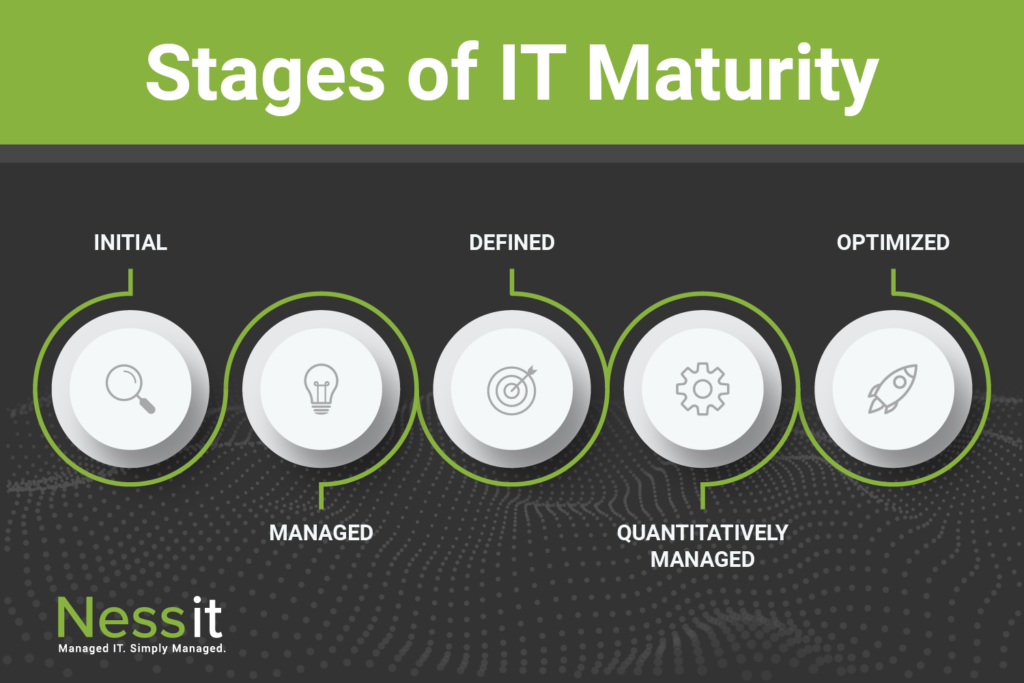Why It’s Important for Your Business and How Nessit Can Help
The effectiveness of your IT infrastructure greatly impacts the success of your business. Having basic IT systems in place is not enough. Achieving IT maturity is critical for long-term growth, innovation, and competitive advantage. So, what exactly is IT maturity, why is it important, and how can Nessit help your business get there?
IT maturity refers to the development and optimization of your organization’s technology infrastructure, processes, and capabilities. As your business evolves, so should your IT strategy, moving from reactive problem-solving to a proactive, streamlined, and strategic approach that integrates technology into every facet of your organization. The more mature the infrastructure, the better your business can adapt to changes, ensure security, improve efficiency, and innovate.
IT maturity is typically categorized through stages, ranging from basic operations to fully optimized systems. The level of maturity usually predicts how well an organization’s IT infrastructure supports its employees, processes, and end-users. The more mature the system is, the less likely a business is to be affected by security breaches, disruptions, and lost productivity. Identifying your organization’s current level of IT maturity is the first step toward optimization.
Stages of IT Maturity
- Initial: At this stage, IT is often ad hoc and reactive, addressing issues as they arise without a cohesive strategy. Processes are inconsistent, insufficiently defined, and poorly documented, and overall IT support is ineffective.
- Managed: IT systems are more structured and managed, but still largely focused on day-to-day operations. Some processes and procedures have been implemented, but there is no overarching strategy. IT is still reactive, rather than proactive.
- Defined: Processes and framework are standardized and documented. IT is more predictable and there is some alignment with business goals. IT is more proactive and progressing toward standardization.
- Quantitatively Managed: Metrics and performance indicators are used to assess and improve IT systems and processes. Objectives are defined and align with business goals. Processes can be measured, duplicated, and tracked, and overall efficiency is improved.
- Optimized: IT is fully integrated with business objectives, driving innovation, automation, and long-term growth. Processes are monitored, updated and continually optimized. Performance is improved and risk is mitigated.

Why is IT Maturity So Important for Businesses?
Achieving IT maturity provides several key benefits for your business.
- Increased Efficiency: Mature IT systems streamline workflows, reduce downtime, and boost productivity by automating repetitive tasks and eliminating bottlenecks.
- Enhanced Security: As your business grows, so do your security risks. IT maturity ensures a robust, proactive approach to cybersecurity, minimizing vulnerabilities, preventing data breaches, and protecting sensitive information.
- Cost Savings: Well-optimized IT systems reduce waste, duplication, and unnecessary IT expenses, providing cost-effective solutions that maximize ROI.
- Scalability and Agility: With a mature infrastructure, your business can easily scale operations and adapt to new market demands or technological advancements. This makes it easier to grow, innovate, and stay competitive in a rapidly changing environment.
- Alignment with Business Goals: Optimized IT means that your technology supports and enhances business goals and objectives, rather than being an afterthought. This alignment promotes a forward-thinking company culture and ultimately drives success.
How Nessit Helps Your Business Achieve IT Maturity
At Nessit, we understand that achieving IT maturity is an ongoing process, not a one-time fix. Every business is unique, and we take the time to really get to know you and your long-term business goals. We work closely with you to assess your organization’s current IT capabilities and create a tailored roadmap to help you reach the highest level of optimization. Here’s how we help:
- Assessment and Strategy Development: Nessit begins by evaluating where your business stands in terms of IT maturity. We identify gaps, inefficiencies, and security risks in your current systems, and then develop a comprehensive IT strategy that aligns with and supports your business goals.
- Proactive IT Management: We take a proactive approach to managing your IT infrastructure. Rather than waiting for issues to arise, we continuously monitor, maintain and optimize your systems to ensure seamless operations and prevent potential problems.
- Security Solutions: Nessit implements cutting-edge cybersecurity measures to protect your business from attacks. We ensure that your security systems are robust and proactive to eliminate any vulnerabilities before they can be exploited.
- Scalable IT: As your business grows, we provide scalable IT solutions to meet new demands and opportunities. Whether you need to add new systems, upgrade infrastructure, onboard new employees, or improve cloud computing capabilities, we help your business stay ahead of the curve.
- Data-Driven Insights: Using advanced analytics and reporting tools, we help you gain deeper insight into your IT performance. This allows you to make smarter business decisions and continually refine your strategies.
- Ongoing Support: Nessit doesn’t just implement solutions. As your IT Managed Service Provider, we provide continuous support and guidance. As industry trends and technology evolve, we make sure your IT systems are always aligned with the latest best practices and innovations.
IT maturity is essential for your business to succeed in a competitive landscape. With the right strategy and support, you can successfully transition your company from reactive IT operations to a fully optimized system that drives efficiency, enhances security, and drives long-term growth. Nessit is here to help you on that journey, from initial evaluation to ongoing support. Our comprehensive IT services ensure that your IT systems evolve with your business. Contact us to learn how we can help your business use technology to thrive. Your success is our success.
